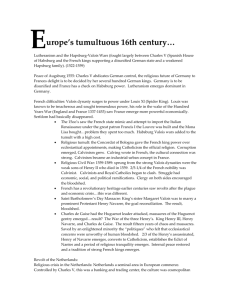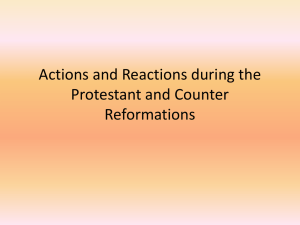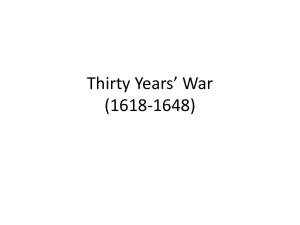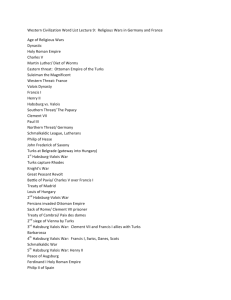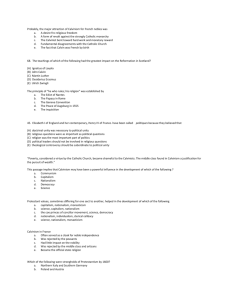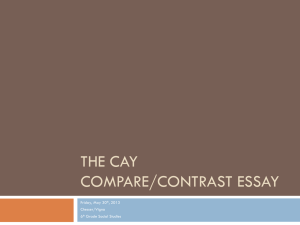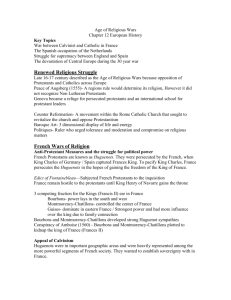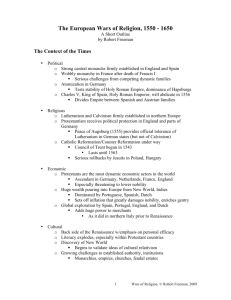Europe`s 16th century
advertisement
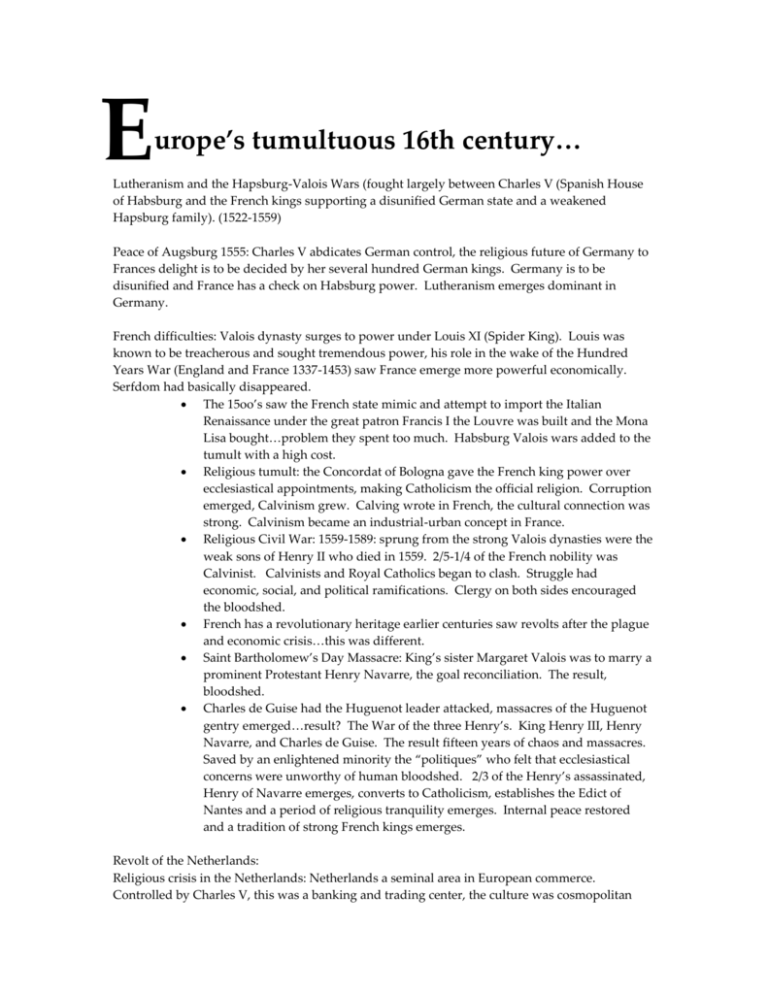
E urope’s tumultuous 16th century… Lutheranism and the Hapsburg-Valois Wars (fought largely between Charles V (Spanish House of Habsburg and the French kings supporting a disunified German state and a weakened Hapsburg family). (1522-1559) Peace of Augsburg 1555: Charles V abdicates German control, the religious future of Germany to Frances delight is to be decided by her several hundred German kings. Germany is to be disunified and France has a check on Habsburg power. Lutheranism emerges dominant in Germany. French difficulties: Valois dynasty surges to power under Louis XI (Spider King). Louis was known to be treacherous and sought tremendous power, his role in the wake of the Hundred Years War (England and France 1337-1453) saw France emerge more powerful economically. Serfdom had basically disappeared. The 15oo’s saw the French state mimic and attempt to import the Italian Renaissance under the great patron Francis I the Louvre was built and the Mona Lisa bought…problem they spent too much. Habsburg Valois wars added to the tumult with a high cost. Religious tumult: the Concordat of Bologna gave the French king power over ecclesiastical appointments, making Catholicism the official religion. Corruption emerged, Calvinism grew. Calving wrote in French, the cultural connection was strong. Calvinism became an industrial-urban concept in France. Religious Civil War: 1559-1589: sprung from the strong Valois dynasties were the weak sons of Henry II who died in 1559. 2/5-1/4 of the French nobility was Calvinist. Calvinists and Royal Catholics began to clash. Struggle had economic, social, and political ramifications. Clergy on both sides encouraged the bloodshed. French has a revolutionary heritage earlier centuries saw revolts after the plague and economic crisis…this was different. Saint Bartholomew’s Day Massacre: King’s sister Margaret Valois was to marry a prominent Protestant Henry Navarre, the goal reconciliation. The result, bloodshed. Charles de Guise had the Huguenot leader attacked, massacres of the Huguenot gentry emerged…result? The War of the three Henry’s. King Henry III, Henry Navarre, and Charles de Guise. The result fifteen years of chaos and massacres. Saved by an enlightened minority the “politiques” who felt that ecclesiastical concerns were unworthy of human bloodshed. 2/3 of the Henry’s assassinated, Henry of Navarre emerges, converts to Catholicism, establishes the Edict of Nantes and a period of religious tranquility emerges. Internal peace restored and a tradition of strong French kings emerges. Revolt of the Netherlands: Religious crisis in the Netherlands: Netherlands a seminal area in European commerce. Controlled by Charles V, this was a banking and trading center, the culture was cosmopolitan and vibrant. Netherlands were 17 independent entities governing themselves under the guise of Habsburg control, Charles V was from the Southern part of the Netherlands around Ghent. Charles kept it together; when he retired he divided the house of Habsburg into two parts: 1. Ferdinand: Austria and the Holy Roman Empire 2. Phillip II: Spain, the Low Countries, Italy, and the Spanish possessions abroad. Calvinism was the problem, it encouraged civil disobedience. 1566 saw a revolt and destruction that eventually settled on the Cathedral of Notre Dame. The building and culture of the area was devastated. From there the violence spread throughout the region. Phillip sent troops to pacify the region, the pacification turned bloody. Civil war raged for 10 years between 1568 and 1578. William of Orange united the seventeen provinces; Spain gradually crushed the revolt in the Southern provinces, the North united into the Union of Utrecht (United Provinces). The Southern part remained Catholic (Belgium) the Northern became the Netherlands (Protestant.) Phillip II didn’t accept this division but the geography (Dikes, Canals, Sluices) made conquest nearly impossible…so the issue turned to England. . Elizabeth didn’t want to antagonize Phillip, but the Netherlands were the most important trading partner for English wool…she also knew that conquest of the region would lead to likely conquest of England by the Spanish. Three developments forced her hand. 1. Struggle hurt the English economy 2. William the Silent (Orange) murdered, military check on Spain removed. 3. Collapse of Antwerp in 1584 posed a serious problem for England, possible Spanish conquest into England? Elizabeth pumps 250,000 pounds into the war effort and sends 2,000 troops, in addition she puts the violently Catholic Mary of Scots (cousin) to death, agitating Phillip II and encouraging him to act. As the self appointed global defender of Catholicism Phillip II could not sit idly by…the Pope encourage him with a 1,ooo,ooo ducat promise of support…Phillip used his South American wealth to launch the Armada a powerful fortress of 130 vessels set to conquer England. England countered with a 150 smaller ships, many of which were set a blaze and using the narrow “Salamis” strategy they were successful. The devastating Spanish result was facilitated by the “Protestant Winds” which devastated the Spanish fleet. The consequences of the war were many: Spain placed a renewed emphasis on naval power, England rallied around the event and emerged more powerful and sought overseas empires, Habsburg domination of Western Europe was now impossible. The Thirty Years War: (1618-1648) · In response to the frail peace established by the peace of Augsburg. The factionist condition of Germany had minimized central control in the region; the principalities were fragmented and allowed for no freedom of religion. The religious climate in Europe was about to erupt. · Lutherans formed the Protestant Union in 1608 and the Catholics responded with the Catholic League of 1609. The two were now in armed camps. · Dynastic issues relating to the Hapsburgs were also at stake. Violence erupted first in Bohemia, in this free region the king-closed Protestant churches…the response the hurling of two ministers out the window of a castle! Thus begins the thirty years war. · War occurred in four phases. o Bohemia: 1618-1625: civil war in Bohemia over religious liberty and independence from the Hapsburgs. Protestants defeated in Bohemia at Battle of White Mountain. o Danish: 1625-1629: Danish lead by the ineffective King Christian IV the ineffective! More catholic victories, 1629 the peak of Hapsburg power. Saw all catholic properties lost since 1552 restored (edict of restitution). Minor sects abolished. Balance of power shifting. o Swedish: 1630-1635: Gustavus Adolphus the Swedish king intervened on behalf of the Protestants to save the Protestants. Gustavus won brilliant military victories solidifying the Protestant come back. He was mortally wounded at Lutzen. The entrance of the Swedes into the conflict saved the protestants and Germans in Europe. The effort suffered after the death of Gustavus Adolphus, however this will inspire the catholic French to join on the side of the Protestants and oppose the Hapsburgs. o French Phase: 1635-1648: the French Phase saw the initiation of the French into the cause. Their support will break the stalemate on behalf of the Protestants and in October of 1648 the Peace of Westphalia was signed bringing about peace to the region. o Impacts of Westphalia: Reorganized Germany, recognized German principalities. Holy Roman Empire destroyed United Provinces of the Netherlands acknowledged. Emergence of French Power. Limit to the power of the Hapsburgs. Calvinism a legally permissible creed. Disaster for European economics Death of unspeakable proportions 1/3 –2/5 of effected areas. Rise in value of labor due to loss of life. Changing Attitudes: · Status of Women: expected to be mature, good household manager, subservient and faithful. Husbands owed fidelity and protection. Had meager advancements in their role in the workplace. Both parties could own property and divorce. Prostitution common for both sexes. Protestant nuns encouraged marrying. · The Great Witch hunt: religious nerves had been exposed and one extension of this was the Witch Hunt of the 16th century, an event that saw thousands executed for their heresy (or what they thought was heresy). Belief in witches was not new, but the religious confusion and tension was. Imagination ran wild as people of all types were thought to have made covenants with the Devil. (Stats 543) · Un diagnosable diseases, sexuality, psychosis, were amongst the causes of witchcraft. · Slavery and Racism: Slavery was common in Europe during the Renaissance and remained so during the era following. The need for importation of Slaves became even more common as expansion and religious wars rolled on. The need for labor became widespread. As this exploitation continued social attitudes emerged as the labor pool shrunk. Elitist attitudes grew as the terms Beastly were associated with these persons. These attitudes will take generations to overturn.
